Scythians: Warriors of Ancient Siberia at the British Museum, London
I was recently in London for business, and was fortunate to visit the Scythians: Warriors of Ancient Siberia exhibit at the British Museum, organized in cooperation with the State Hermitage Museum, St. Petersburg, Russia (another place I am hoping to visit in this lifetime).
A nomadic people, the Scythians flourished roughly 900 BCE – 200 BCE, traversing the steppes and plains of Siberia. Through formal cultural exchange and pillage, they both absorbed and influenced the Greek, Assyrian, and Persian civilizations of their time. Much of what we know is from the recorded histories of those cultures (as the Scythians did not have written records of their own) and from burial mounds. You can read the museum’s introduction to the exhibit on its blog.
The exhibit is large, and well-organized. I spent rather a lot of time in the jewelry and precious objects display, because, well, jewelry. I have no photos of my own (no photography permitted in the exhibit), so I am relying on the museum photos.
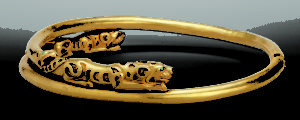
Gold torc with turquoise inlays. © The State Hermitage Museum, St Petersburg, 2017. Photo: V Terebenin.
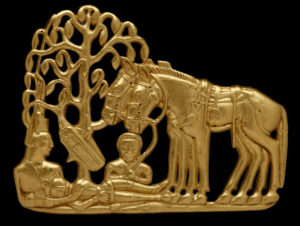
Scythians with horses under a tree. Gold belt plaque. Siberia, 4th–3rd century BC. © The State Hermitage Museum, St Petersburg, 2017. Photo: V Terebenin.
The Scythians were fierce warriors, tattoed, attired in wool and tall hats, and rode like the wind, striking fear into the hearts of their opponents.
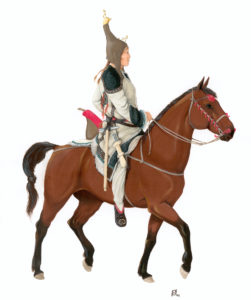
Artist’s impression of a Scythian on a horse. Reconstruction by D V Pozdnjakov.
Their horses were also fitted with leather armor and tall headpieces, creating an even more impressive and frightening appearance.
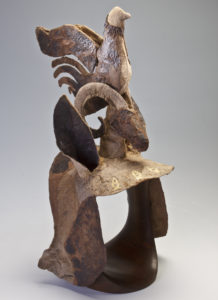
Horse headgear. Mound 1, Pazyryk, Altai. Late 4th–early 3rd century BC. © The State Hermitage Museum, St Petersburg, 2017. Photo- V Terebenin
They drank for fun (to excess, according to the Greeks and Persians) and used hemp as a pain reliever. Which is important when you’ve been riding all day, and doing battle.
The image that struck me, and stayed with me, is The Golden Beast:
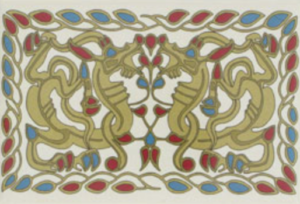
Scythian Golden Beast, Image by British Museum, London, UK.
Two dragons face each other, with a Tree of Life in the center. It wasn’t available as an art print, so I ended up with a tea towel, as that was the only option for capturing the image among the gift shop goods.
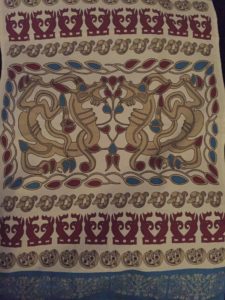
Scythian Dragons with Tree of Life tea towel – my photo
If you look closely at the borders, you will also see rams, stags, and panthers. It’s now part of my altar set up.
I also indulged in this hand-carved horn comb, ornamented with a phoenix. (No, it’s not an original artifact, merely a copy!)
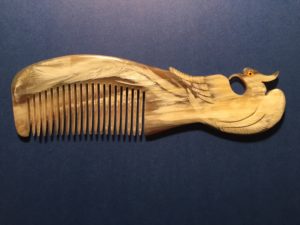
Scythian-Style Carved Horn Comb with Phoenix – my photo
A nomadic, fierce warrior people, known for fighting and drinking, and fond of shiny objects, with favored mythical beasts of dragons and wolves, and a Tree of Life as the center of their mythology.
Hm. This sounds so familiar. If only I could figure out what this reminds me of . . . .
The exhibit is on through January 14, 2018. If you have the chance to see it, I recommend it highly! If not, you can always order the exhibit catalog from the British Museum online gift shop.
